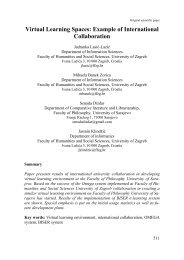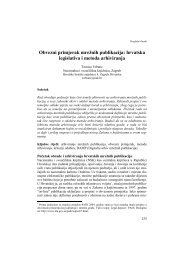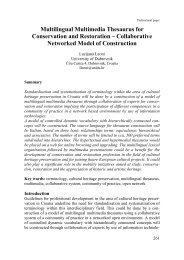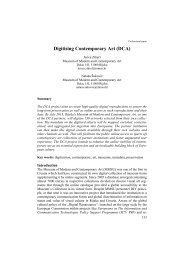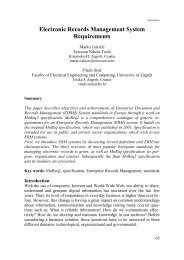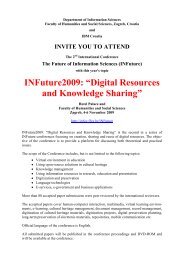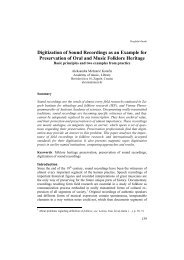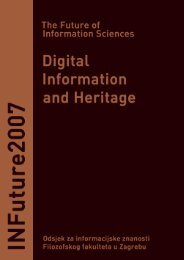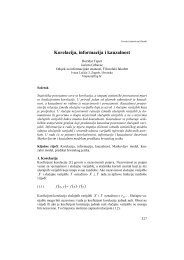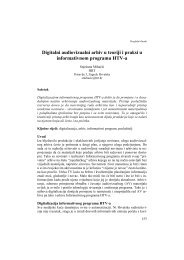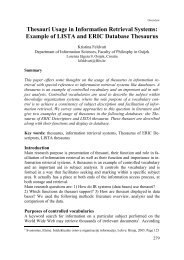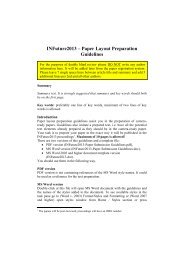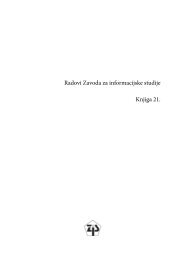Slovenian Biographical Lexicon ? From a Digital Edition to an On ...
Slovenian Biographical Lexicon ? From a Digital Edition to an On ...
Slovenian Biographical Lexicon ? From a Digital Edition to an On ...
You also want an ePaper? Increase the reach of your titles
YUMPU automatically turns print PDFs into web optimized ePapers that Google loves.
INFuture2009: “<strong>Digital</strong> Resources <strong>an</strong>d Knowledge Sharing”<br />
tion of data pertaining <strong>to</strong> people <strong>an</strong>d places <strong>an</strong>d improved specifications for encoding<br />
textual alternatives. Additionally, TEI P5 takes adv<strong>an</strong>tage of the power<br />
of XML schema l<strong>an</strong>guages, so that other XML tag-sets, such as MathML or<br />
SVG, c<strong>an</strong> now be referenced from within a TEI document <strong>an</strong>d a TEI document<br />
c<strong>an</strong> be embedded within other types of XML documents, such as METS <strong>an</strong>d<br />
MODS records (Burnard, Baum<strong>an</strong>, 2007), which turned out <strong>to</strong> be crucial for the<br />
implementation of our on-line reposi<strong>to</strong>ry, since this makes TEI a well-behaved<br />
XML citizen, able <strong>to</strong> take part in <strong>an</strong>y, however complex, XML processing<br />
chains <strong>an</strong>d composite documents.<br />
XML Data Source Structure<br />
The vast majority of SBL articles present information on the life <strong>an</strong>d actions of<br />
a single person, while some describe well known families, detailing life <strong>an</strong>d<br />
work of several members of the family. An article usually starts with the name<br />
of the person or the family, its vari<strong>an</strong>ts, mostly those used <strong>to</strong>wards the end of<br />
their life or the most generally used, followed by a chronological summary of<br />
the person’s life <strong>an</strong>d activity, including birth, death, locations, occupations, activities<br />
etc. An article may consist of one (usually) or m<strong>an</strong>y paragraphs, depending<br />
on the exhaustiveness of the article, <strong>an</strong>d is written in dense l<strong>an</strong>guage,<br />
using abbreviations wherever possible, ending with a brief bibliography <strong>an</strong>d<br />
other materials relev<strong>an</strong>t <strong>to</strong> the person, such as portraits or pho<strong>to</strong>graphs.<br />
The text of the articles has been digitized <strong>an</strong>d m<strong>an</strong>ually revised <strong>to</strong> fix OCR errors<br />
before it was au<strong>to</strong>matically converted in<strong>to</strong> the basic TEI-XML format. In<br />
the next stage, segments of text that needed <strong>to</strong> be marked up but could not be<br />
identified au<strong>to</strong>matically had <strong>to</strong> be tagged m<strong>an</strong>ually, in particular with details<br />
such as different vari<strong>an</strong>ts of names (linguistic <strong>an</strong>d orographic variations, married<br />
names, ecclesiastic names <strong>an</strong>d titles, pseudonyms, complex name parts in<br />
the case of foreign names <strong>an</strong>d names with denotation of nobility etc.), making<br />
the process slow <strong>an</strong>d error-prone. Since the original data was not normalized,<br />
considerable effort had <strong>to</strong> be spent <strong>to</strong> achieve high quality TEI XML mark up,<br />
<strong>an</strong>d some work with data normalization is still ongoing. (The major aspects of<br />
this conversion process have been reported in more detail in Vide Ogrin, Erjavec<br />
2007). In this m<strong>an</strong>ner, essential information about the subject of the article<br />
<strong>an</strong>d its bibliographical section have been encoded with special purpose elements<br />
from TEI P5 biographical <strong>an</strong>d prosopographical modules, representing<br />
each article as a element starting with a element, which<br />
contains the detailed information on the subject of the article (names, sex,<br />
birth/death date <strong>an</strong>d location, locations of activities, occupations or activities<br />
etc.), but also meta data, (volume <strong>an</strong>d year of the first publication, author of the<br />
article, revision status etc.). This element is followed with one or more <br />
elements with the article text <strong>an</strong>d a element with the extracted bibliographical<br />
data.<br />
254


